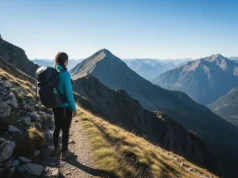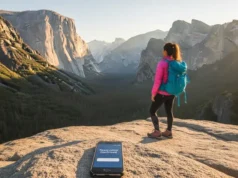In this article
A hiking checklist is more than just a list of gear; it’s a system built on decades of experience that fosters self-reliance for any hike. In the backcountry, help can be hours or even days away, and the line between a minor mishap and a serious emergency is often preparedness. A sobering analysis of SAR operations in U.S. National Parks shows that hiking accounts for nearly half of all incidents, with roughly 70% stemming from preventable errors, not major accidents. This is precisely the problem this guide is designed to solve, which is invaluable information for anyone starting the activity
The Ten Essentials are not just a packing list but a time-tested survival philosophy developed by The Mountaineers in the 1930s. Its purpose is twofold: to prevent small problems from escalating into dangerous emergencies and to enable you to survive an unexpected night outdoors. This guide will deconstruct this philosophy, detail each of the modern “Essential Systems,” and provide a well-crafted hiking checklist tailored for every type of outdoor expedition, from a short day hike to multi-day winter treks.
The Ten Essential Systems: What To Bring On Every Hike
A detailed breakdown of the modern Ten Essentials reveals an important shift in thinking. The approach has evolved from a rigid hiking essentials list to a flexible framework of functions. This system-based thinking about essential hiking gear empowers you to pack smarter and more critically for any adventure, ensuring you have the right hiking equipment for the specific conditions you’ll face on the trail.
1. Navigation: How to Stay Found
The primary purpose of your navigation system is to accurately determine your location and stay on your intended hiking trail. Getting lost is a primary trigger for many other emergencies, from being caught in the dark to exposure to bad weather, making this the most critical system. The core components are a topographic trail map stored in a waterproof case and a reliable baseplate-style compass. These battery-free tools are non-negotiable for any trip into the wilderness, as simplified visitor center maps are often inadequate for true off-trail navigation on unfamiliar trails.
Modern technology, like a dedicated GPS unit or using a smartphone app with offline maps, offers powerful assistance. These tools are fragile and battery-dependent, so they should always supplement, not replace, your map and compass. Always download maps for offline use before you lose service. Advanced tools like an altimeter watch or a Personal Locator Beacon (PLB) provide an extra layer of safety for remote hikes, aligning with the official gear standards from The Mountaineers.
2. Sun Protection: Shielding from UV Rays
This system protects your skin and eyes from harmful UV radiation, which intensifies at high altitude and reflects off snow and water in the mountains. It prevents severe sunburn, long-term skin cancer risks, and acute emergencies like snow blindness. High-quality sunglasses that block 100% of UVA/UVB rays are a must. For travel on snow, specialized glacier glasses with a very low light transmission rating are required.
Broad-spectrum sunscreen with an SPF of 30 or higher should be applied frequently, but sun-protective outdoor clothing provides more consistent protection. Don’t forget often-overlooked items like a wide-brimmed hiking hat to shield your face, ears, and neck, along with an SPF-rated lip balm. This approach follows the advice from the American Hiking Society for comprehensive coverage.
3. Insulation: Your Emergency Warmth Layer
This system is not the clothes you start the hike in; it’s the extra layers you carry to survive an unexpected night out in the worst possible conditions for that environment. Hypothermia is a primary killer in the backcountry, and these extra clothes are your main defense. The foundational concept is understanding how the layering principle works. This involves a moisture-wicking base layer, an insulating mid-layer like a fleece pullover, and a waterproof and windproof outer shell or warm jacket.
One non-negotiable rule is to avoid cotton at all costs. Cotton absorbs moisture, loses its insulating properties when wet, and has earned the nickname “killer fabric” in the outdoors. Always choose wool or synthetic fabrics instead. Your pack should always contain extra items like a set of long underwear, an extra insulating hat, an extra pair of wool socks, and an insulating puffy vest or hiking jacket.
4. Illumination: Navigating After Dark
A reliable light source is vital because a hike can frequently take longer than planned. Getting caught on the trail after dark without a light is a common reason for search and rescue calls and can turn a simple delay into a disorienting and dangerous situation. We strongly recommend a headlamp over a flashlight because it keeps your hands free for tasks like using trekking poles or checking your map.
Always carry extra batteries. For winter hiking, lithium batteries perform better in cold temperatures. A useful tip is to store them reversed inside your device to prevent accidental power drain. For redundancy, a tiny backup light, like a keychain LED, is a wise addition. Your phone’s flashlight should only be used as a last resort due to its poor battery life. Every packing list of things to take hiking should include a reliable headlamp with extra batteries.
5. First-Aid Supplies: Managing Trail Injuries
The purpose of a first-aid kit is to treat common trail injuries like blisters, cuts, and sprains where professional medical aid is not immediately available. Customization is key; while pre-made kits are a good start, an effective kit is tailored to the trip’s duration, group size, and personal needs like EpiPens or insulin.
A comprehensive kit of first-aid supplies goes beyond simple bandages. It should include wound care items like gauze and antiseptic wipes, blister care such as moleskin, medications like pain relievers, and tools like tweezers and trauma shears. The most important component is knowledge; a kit is worthless without the skills to use it effectively. Taking a Wilderness First Aid course is highly recommended for any serious hiker. Your commitment to building a comprehensive first-aid kit is a commitment to your own safety.
6. Fire: Your Emergency Heat Source
In a survival situation, fire can be a lifesaver. It provides warmth to combat hypothermia, can be used to signal for help, boils water for purification, and offers a significant morale boost. Your kit should have redundant ignition sources. Carry at least two reliable methods, like a disposable butane lighter and waterproof matches stored in a waterproof container. Flimsy paper matchbooks are not sufficient for a backcountry camping trip.
Firestarter, or tinder, is the most critical component, especially in the wet woods. Pack items like petroleum jelly-coated cotton balls, commercial fire tabs, or dryer lint to help ignite damp kindling. In environments without firewood, such as high alpine zones, a backpacking stove and fuel become your emergency fire system. Always check and adhere to local fire regulations before your trip.
7. Repair Kit & Tools: Fixing Gear on the Fly
This system allows for on-the-trail repairs of critical equipment. A torn backpack strap, a ripped tent, or a delaminating boot sole can quickly escalate from an annoyance to a serious problem miles from the trailhead. Every adult should carry a knife or a multi-tool for countless tasks, from first aid to gear repair. Duct tape is the quintessential backcountry repair item; a space-saving tip is wrapping duct tape around a trekking pole instead of carrying the entire roll.
A good kit combines general and specialized repair items. We recommend packing gear-specific patches for sleeping pads or rain jackets, a few zip ties, safety pins, and strong thread with a needle. A few feet of extra cordage or a spare shoelace can also be incredibly useful. As experts note, a comprehensive repair kit should include a mix of these multi-purpose and specific items.
8. Nutrition: Fuel for Emergencies
The extra food you bring serves as a critical energy reserve if your hike is unexpectedly extended by getting lost, an injury, or bad weather. These calories are essential for maintaining energy, generating metabolic heat for warmth, and ensuring clear thinking in a stressful situation. A good rule of thumb is to carry at least one full extra day’s supply of food beyond what you plan to eat for the day.
Ideal emergency food items should be calorie-dense, have a long shelf life, and require no cooking. Excellent examples include energy bars, beef jerky, nuts, dried fruit, and classic trail snacks like trail mix. Do not make the common mistake of under-fueling for the planned portion of your hike. Hiking burns a tremendous number of calories, and packing enough camping food for performance is just as important as the emergency supply.
9. Hydration: Carrying and Treating Water
This system ensures you have enough water to drink and the means to resupply from natural sources. The risk of dehydration on the trail is serious and can quickly impair judgment, leading to heat exhaustion or altitude sickness. You should start every hike with full water bottles, planning for at least a half-liter to a full liter per hour of activity, carrying even more in hot or high-altitude conditions.
The most critical part of this system is the ability to treat water from streams and lakes, which saves significant weight and is a crucial safety measure. The primary methods for treatment are filtering, purifying, and boiling. On long or strenuous hikes, it’s also important to replace electrolytes lost through sweat. Supplementing water with electrolyte powders or tablets helps maintain proper body function and prevents hyponatremia.
10. Emergency Shelter: Your Lifesaving Backup
This is your backup plan, a personal shelter designed to provide immediate, life-saving protection from wind and rain if you are unexpectedly forced to spend a night outdoors. It is a backup to your rain gear, intended for a static emergency. Effective options include an ultralight tarp, a dedicated emergency bivy sack, or even a large, heavy-duty trash bag. Heat-reflective emergency bivies are a major improvement over simple blankets.
Be wary of relying solely on thin, crinkly “space blankets.” They tear easily in wind and provide minimal real-world protection. A more robust bivy is a safer choice for a marginal weight increase. For serious hikers, upgrading to an emergency bivy sack is a wise investment. Your primary backpacking tent only counts as an emergency shelter if you have it with you at all times. If you leave it at a basecamp or campsite for a day hike, you must carry a separate, lightweight emergency shelter in your daypack.
Adapting Your Checklist: Gear for Your Specific Adventure
The Ten Essentials provide a universal foundation, but intelligent packing means adapting that foundation to your trip’s specific context. Knowing what to bring hiking involves adjusting your list for the duration of your hike, the season’s weather, and the type of group you’re with, ensuring you’re prepared for your specific adventure.
For a Short Day Hike vs. a Multi-Day Trek
The main difference between a day hike and a multi-day trek is the need for complete self-sufficiency on longer trips. For shorter treks or a 2-hour hike on familiar, smooth trails, a minimalist kit might suffice. For any hike over two hours or in remote terrain, the full Ten Essential Systems become non-negotiable, requiring a larger pack to carry more water, a filter, more food, and extra layers.
For a multi-day backpacking trip, your gear list expands significantly. A comprehensive backpacking checklist for multi-day trips is a must, especially for a thru-hike like the 210-mile John Muir Trail. The primary difference involves carrying the “Big Three”: your backpack, sleeping bag, and sleeping pad. These are the additions for multi-day backpacking that transform a day hiker into an overnighter. Other expanded systems include a full cooking setup with backpacking meals, multiple days’ worth of food and proper food storage like a bear canister, and more extensive clothing.
What to Bring Hiking in Summer vs. Winter
In summer, the focus shifts from core warmth to cooling, hydration, and sun protection. Your outdoor wear should be lightweight and breathable; UPF sun hoodies are an excellent choice. You can find excellent advice on what to wear hiking in summer online, with your go-to hiking shorts (like Patagonia Baggies) being a staple. The need for water and electrolytes increases dramatically in the heat.
In winter, the margin for error shrinks. The “cotton kills” rule is absolute. Your layering system becomes more robust, with heavyweight base layers, multiple insulating mid-layers, and a waterproof/windproof hard-shell jacket and pants. Specialized winter hiking gear like insulated, waterproof hiking shoes, tall gaiters, and a traction system becomes mandatory for rugged terrains that may be rocky or covered in ice. You must also account for winter-specific challenges, such as using insulated water bottles to prevent freezing and lithium batteries in electronics.
Checklists for Solo Hikers and Hiking with Kids
The solo hiker must embrace heightened self-sufficiency and redundant systems. The most critical piece of specialized gear is an emergency communication device like a satellite messenger or PLB for areas without cell service. Solo hikers must have impeccable navigation skills and a complete first-aid kit with the knowledge to perform self-care. Always leave a detailed trip plan with a trusted contact.
When hiking with kids, the adult’s pack expands to carry extra food, water, and layers for the child, who can get cold or dehydrated much faster. The first-aid kit must include child-specific items. It’s smart to review what to pack for a hike with kids () before heading out. Give the child their own small pack with a safety whistle, snacks, and engagement tools like binoculars or a field guide to the local wildlife to make the hike enjoyable and educational.
The Most Important Essential: Judgment & Avoiding Common Mistakes
Gear is only one part of the preparedness equation. True readiness for any outdoor expedition comes from knowledge, sound judgment, and learning from the common errors that lead to dangerous situations. Your brain is the most important essential you carry, and developing good judgment is the ultimate goal of practicing self-reliance in the great outdoors.
Learning from Rescues & Preventing Common Injuries
Data from search and rescue reports reveal that most rescues are triggered not by catastrophes but by preventable errors. Getting lost reinforces the need for navigation, being caught after dark highlights the importance of illumination, and a minor injury turning serious underscores the value of first-aid. The data on hiker injuries shows that blisters, sprains, and strains of the lower extremities are among the most common preventable issues.
Your best defense against these common ailments is properly fitting, well-broken-in footwear () like solid hiking shoes, paired with quality wool or synthetic good hiking socks. Using trekking poles can significantly reduce strain on your knees and help prevent the slips and falls from tripping that account for about half of all traumatic injuries. Many injuries are also the result of doing “too much, too soon.” Pre-hike conditioning and listening to your body are key to a successful hiking trip.
Your Checklist for a Lifetime of Adventure
The Ten Essentials are a philosophy of self-reliance, not a rigid, one-size-fits-all list of things to bring on a hike. Preparedness is about breaking the chain of small, compounding errors that can lead to an emergency. It’s about thinking through the “what-ifs” before you leave the trailhead so you have the tools and knowledge to handle what nature offers.
The most critical essential you possess is your judgment. A map is useless without the skill to read it, and a first-aid kit is useless without the training to use it. Adopt the Ten Essential Systems as the foundation for every trip, but always adapt them to your specific hiking journey. By committing to continuous learning—practicing navigation, taking a first-aid course, and reflecting on every experience—you develop the confidence and competence that unlocks a lifetime of safe and confident adventures.
Frequently Asked Questions about What to Bring on a Hike
Do I really need to carry all Ten Essentials for a short, popular hike? +
What is the single biggest mistake beginner hikers make when packing? +
I want to be safe, but my pack is too heavy. How can I reduce weight? +
What’s more important for insulation: a down or a synthetic jacket? +
We are a participant in the Amazon Services LLC Associates Program, an affiliate advertising program designed to provide a means for sites to earn advertising fees by advertising and linking to Amazon.com. As an Amazon Associate I earn from qualifying purchases. We also participate in other affiliate programs. The information provided on this website is provided for entertainment purposes only. We make no representations or warranties of any kind, expressed or implied, about the completeness, accuracy, adequacy, legality, usefulness, reliability, suitability, or availability of the information, or about anything else. Any reliance you place on the information is therefore strictly at your own risk. Additional terms are found in the terms of service.





